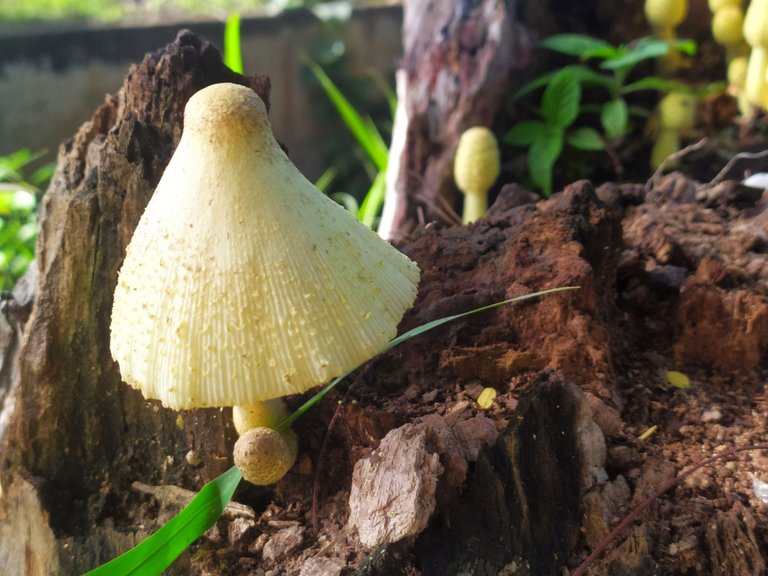
After a really strong storm during sunday night past week, I went to work early in the monday morning. Everything was wet , foggy, and lively green. I was waiting for the bus under some trees, and I noticed over the remmants of a tree bark some yellowy dots. After approaching I could finally see those were mushrooms. It was the first time I encounter those, and at the time I didn't know even their name. nonetheless, I found them beautiful among the reddish tree bark and the lively green around them. Here I share my little discovery and what I learned about it.
Después de una tormenta muy fuerte durante la noche del domingo de la semana pasada, fui a trabajar temprano el lunes por la mañana. Todo estaba mojado, neblinoso y de un verde vivo. Estaba esperando el autobús debajo de unos árboles y noté sobre los restos de la corteza de un árbol algunos puntos amarillentos. Después de acercarme finalmente pude ver que eran hongos. Era la primera vez que los encuentro, y en ese momento ni siquiera sabía su nombre. sin embargo, los encontré hermosos entre la corteza rojiza de los árboles y el verde vivo que los rodeaba. Aquí les comparto mi pequeño descubrimiento y lo que aprendí al respecto.

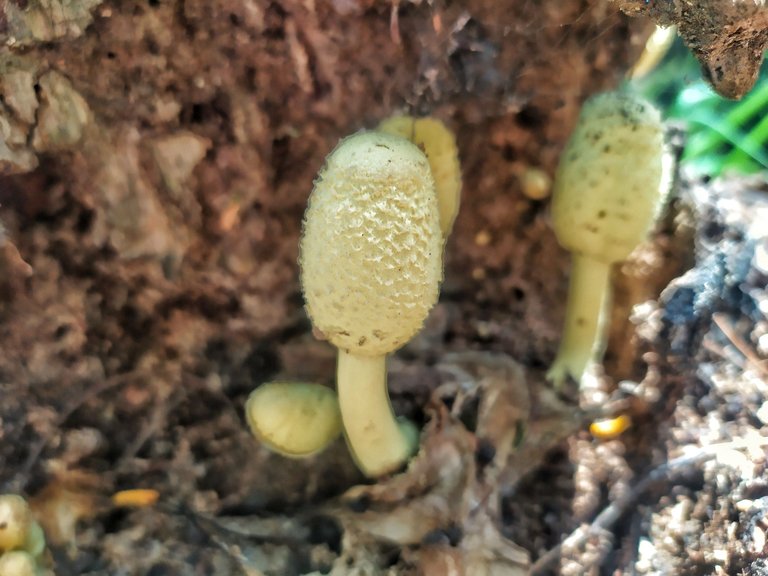
|
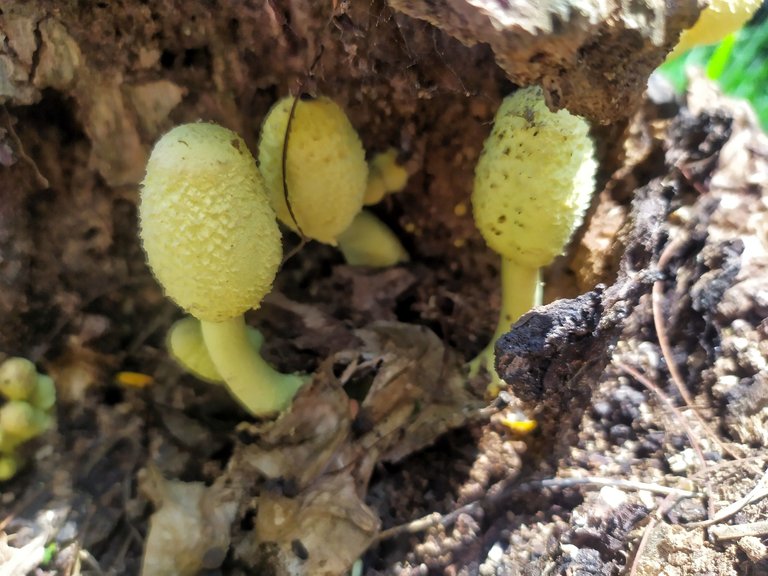
|
Its scientific name is Leucocoprinus birnbaumii, it is also knowns commonly as plantpot dapperling. It is a fungi that proper of tropic and subtropic regions, and can also be found on plant pots (there the reason of its name) in less tropic weathers. It is poisonous, so we cannot eat it without severely affecting the stomach. Its main source of nutrients is compost or humus (dead matter), and as you can see this one grew over a dead tree among wet, dead leaves.
Su nombre científico es Leucocoprinus birnbaumii, también se le conoce comúnmente como amarillo de maceta o parasol amarillo. Es un hongo propio de regiones tropicales y subtropicales, pudiendo encontrarse también en macetas (de ahí su nombre) en climas menos tropicales. Es venenoso, por lo que no podemos comerlo sin afectar gravemente al estómago. Su principal fuente de nutrientes es el compost o humus (materia muerta), y como podéis ver este creció sobre un árbol muerto entre hojas muertas y mojadas.
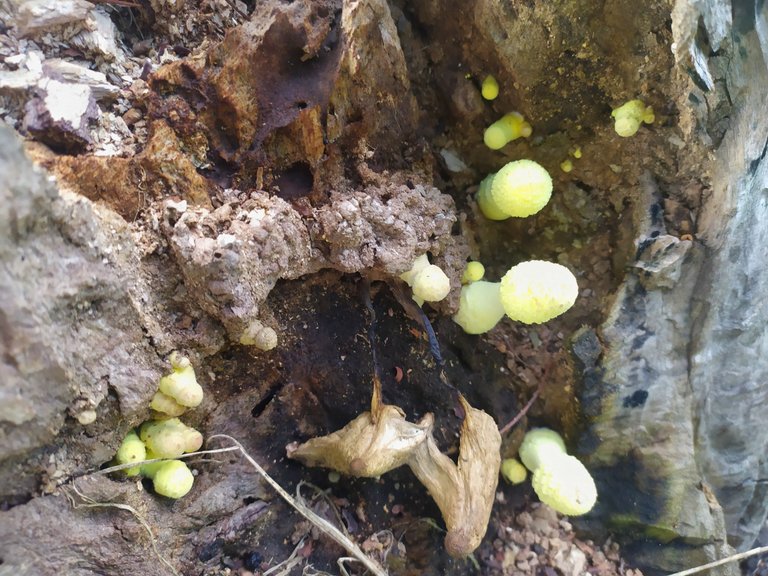
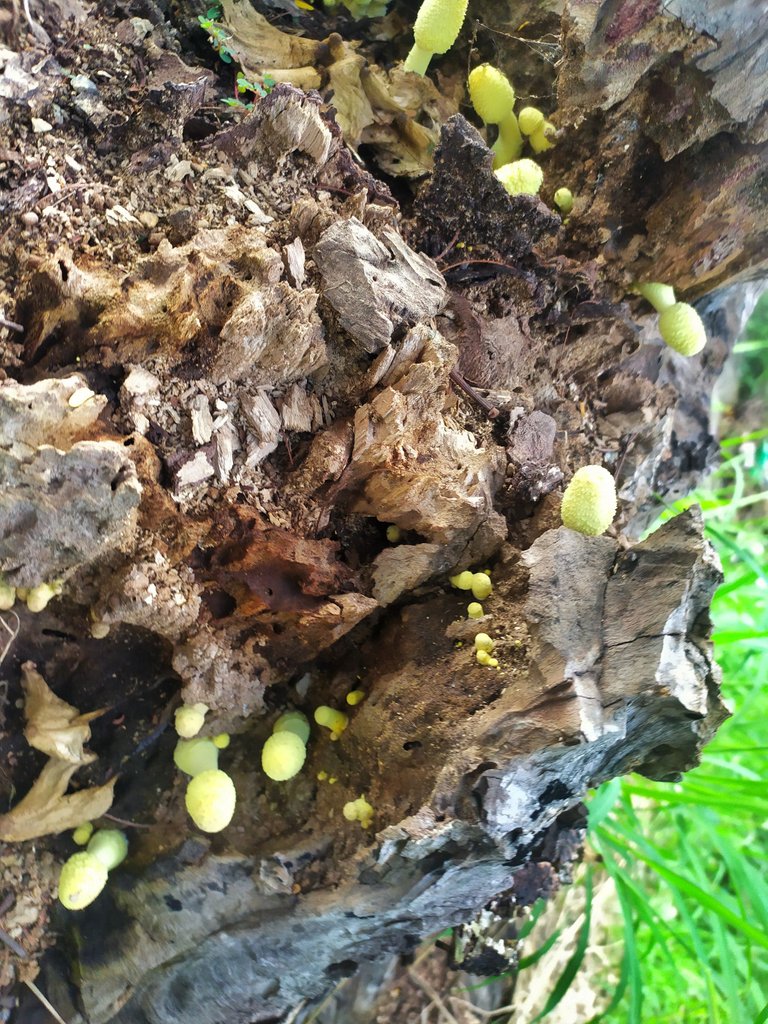
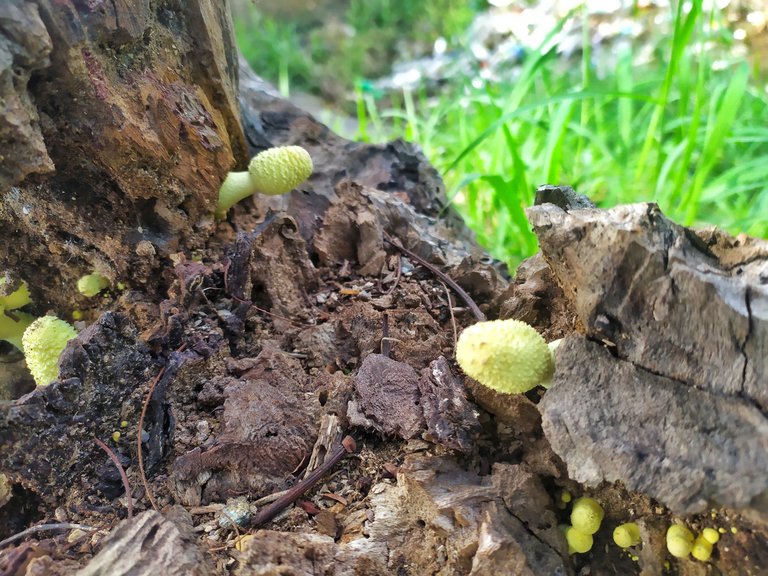
|
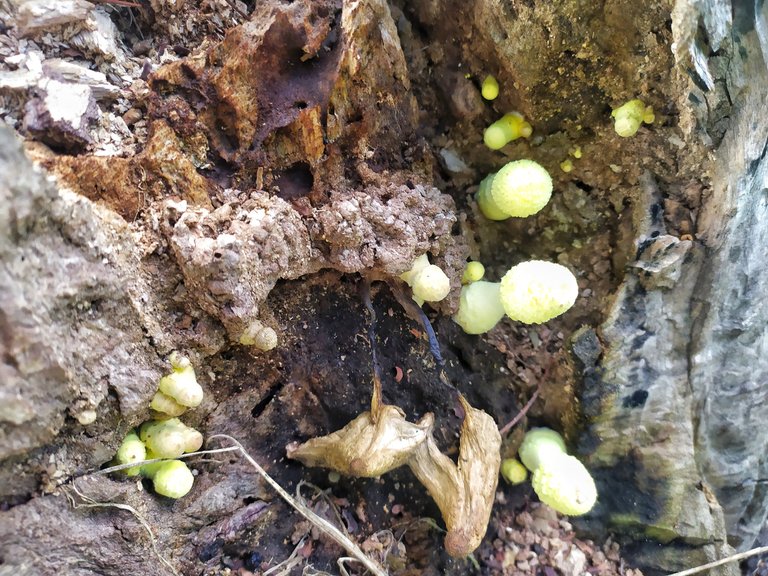
|
At first the mushroom only grow conic forms with a highly texturized head, but as it evolves it develops a parasol shape cap that can grow up to 10cm of height and around 2.5 to 5cm of diameter. on its surface it is filled with scales not present in its stem. This last part has a ring a few inches down and a cup at its base. For it to grow, it needs two main conditions: high humidity and warm temperature. So, I guess the long storm gave enough humidity and the regular heat of our valley did the rest for these tiny bulbs to be born. They also appear if we water out plants (inside pots) too frequently which is not recommended. we don't want these around our plants because it feeds from the nutrients that are there for them. We can use copper or sulfur powders to prevent this. Another solution is to create a soda dilution and use a spray to keep the fungus from growing.
Al principio, el hongo solo desarrolla formas cónicas con una cabeza muy texturizada, pero a medida que evoluciona desarrolla un sombrero en forma de sombrilla que puede crecer hasta 10 cm de altura y alrededor de 2,5 a 5 cm de diámetro. en su superficie está lleno de escamas que no están presentes en su tallo. Esta última parte tiene un anillo unos centímetros hacia abajo y una copa en su base. Para que crezca, necesita dos condiciones principales: alta humedad y temperatura cálida. Entonces, supongo que la larga tormenta dio suficiente humedad y el calor regular de nuestro valle hizo el resto para que nacieran estos pequeños bulbos. También aparecen si regamos las plantas (dentro de las macetas) con demasiada frecuencia, lo que no es recomendable. no los queremos alrededor de nuestras plantas porque se alimenta de los nutrientes que están ahí para ellos. Podemos utilizar polvos de cobre o azufre para evitarlo. Otra solución es crear una dilución de soda y usar un spray para evitar que crezca el hongo.
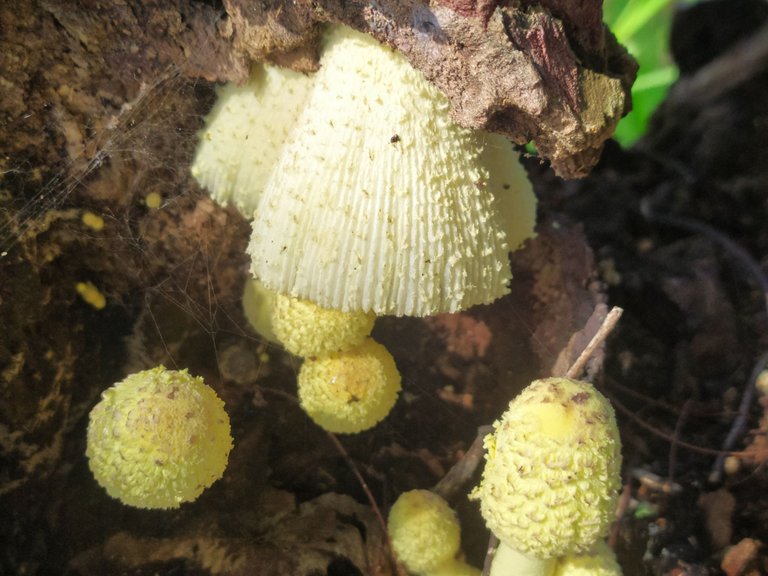
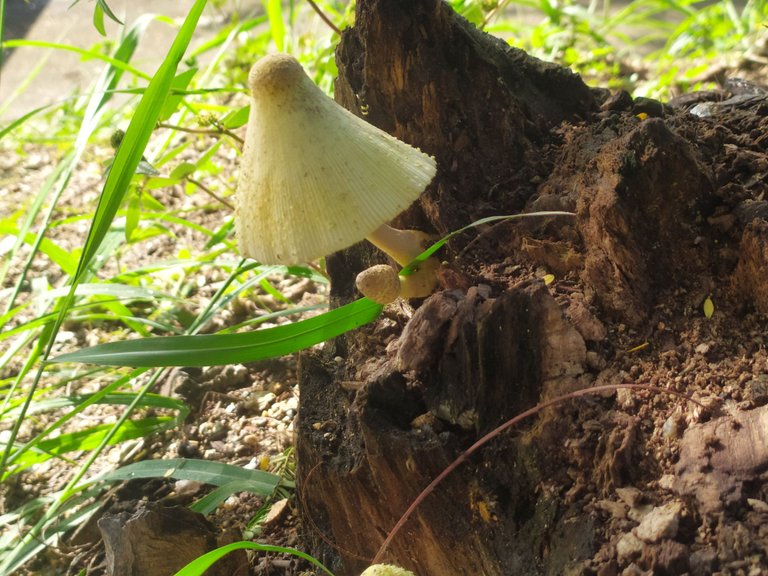
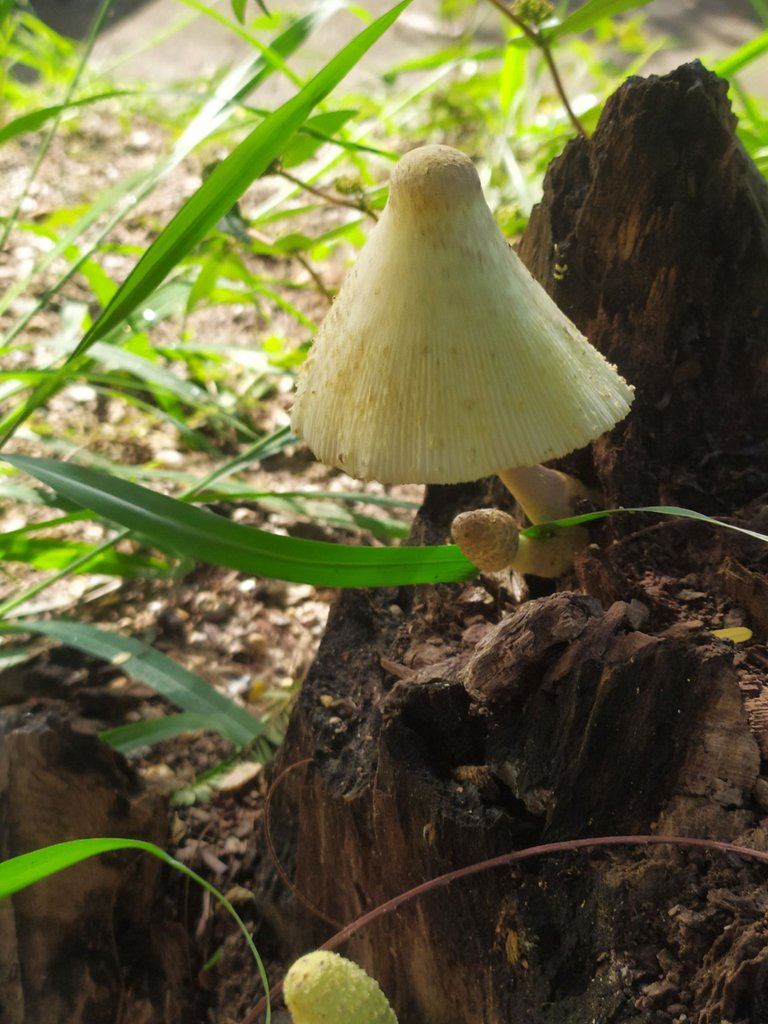
Even though it is supposed to be common here, it is the first time I see it. Being a fan of tree barks, I also pay attention to the fungi that grows on them. I think this yellow color is particularly beautiful; although over time it becomes paler. It was a nice morning surprise that almost made me lose my bus lol.
Aunque se supone que es común aquí, es la primera vez que lo veo. Siendo fanático de las cortezas de los árboles, también presto atención a los hongos que crecen en ellos. Creo que este color amarillo es particularmente hermoso; aunque con el tiempo se vuelve más pálido. Fue una agradable sorpresa matutina que casi me hizo perder mi autobús jajaja.
@gaeljosser
Redmi Note 7 camera
Edition with Snapseed
The rewards earned on this comment will go directly to the people( @gaeljosser ) sharing the post on Twitter as long as they are registered with @poshtoken. Sign up at https://hiveposh.com.
The mushrooms look quite appetizing. It's scary that someone might eat them not knowing they're poisonous. 😦
Indeed! specially the scale on its surface contain quite some toxins. I read there's a part that could be eaten, but it is just not worth the risk in my opinion.
Even among the dead trees and leaves, life can grow. Cool.
The life's cycle, exactly.
I appreciate your work and your post has been manually curated by Botanic team @oscurity on behalf of Amazing Nature Community. Keep up the good work!
If you want to receive votes from our DNA team, I invite you to create scientific content identifying the species photographed and using bibliographic sources!
Dear @gaeljosser, sorry to jump in a bit off-topic.
May I ask you to review and support the new proposal (https://peakd.com/me/proposals/240) so I can continue to improve and maintain this service?
You can support the new proposal (#240) on Peakd, Ecency,
Thank you!